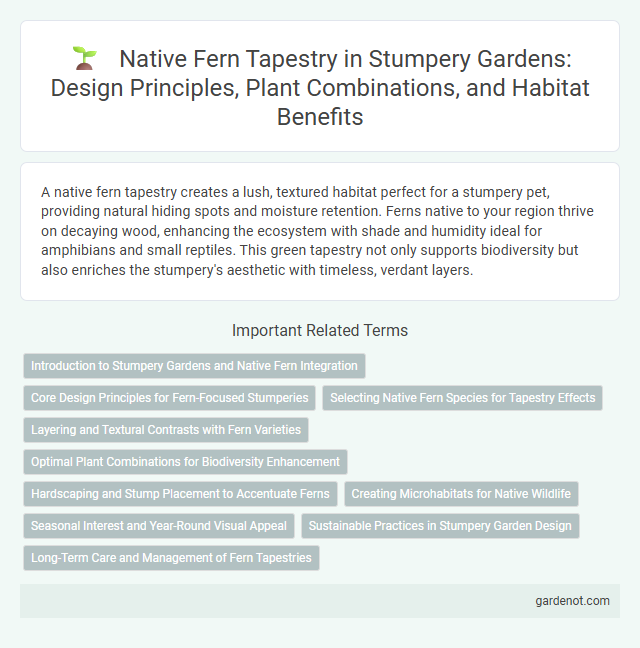A native fern tapestry creates a lush, textured habitat perfect for a stumpery pet, providing natural hiding spots and moisture retention. Ferns native to your region thrive on decaying wood, enhancing the ecosystem with shade and humidity ideal for amphibians and small reptiles. This green tapestry not only supports biodiversity but also enriches the stumpery's aesthetic with timeless, verdant layers.
Introduction to Stumpery Gardens and Native Fern Integration
Stumpery gardens artfully combine native ferns with decayed wood, creating a naturalistic tapestry that enhances biodiversity and aesthetic appeal. These structures provide ideal habitats for shade-loving ferns such as Polystichum and Dryopteris, fostering a lush, textured landscape unique to temperate woodland environments. Integrating native ferns into stumperies supports local ecosystems by promoting native plant conservation and soil health.
Core Design Principles for Fern-Focused Stumperies
Native fern tapestry in stumperies emphasizes the core design principles of texture contrast, layering, and naturalistic placement to showcase fern diversity and structure. Selecting a variety of native ferns with differing frond shapes and shades enhances visual interest while mimicking woodland ecosystems. Strategic grouping of species like Polystichum munitum and Dryopteris ensures both aesthetic harmony and ecological authenticity in fern-focused stumperies.
Selecting Native Fern Species for Tapestry Effects
Selecting native fern species for a stumpery focuses on varieties like Polystichum munitum, Athyrium filix-femina, and Dryopteris marginalis, prized for their intricate frond patterns and varying shades of green. These ferns create textural depth and natural gradients, enhancing the tapestry's visual complexity and ecological authenticity. Prioritizing shade-tolerant species ensures lush growth under woodland canopies, contributing to a thriving, low-maintenance stumpery display.
Layering and Textural Contrasts with Fern Varieties
Layering native fern varieties in a stumpery creates rich textural contrasts, enhancing visual depth and natural complexity. Combining delicate fronds of maidenhair fern with the robust foliage of male fern produces dynamic patterns that emphasize diversity in shape and color. Strategic placement of shade-tolerant species like hart's tongue fern further accentuates the interplay between light and shadow, making the fern tapestry visually captivating.
Optimal Plant Combinations for Biodiversity Enhancement
In a stumpery, native fern tapestry thrives by pairing shade-loving species like Polystichum setiferum with moisture-tolerant Athyrium filix-femina to create layered habitats that support diverse invertebrates and microfauna. Integrating companion plants such as Epimedium and Tiarella further enriches soil health and provides nectar sources, boosting overall ecosystem resilience. Strategic plant combinations maximize biodiversity by mimicking natural woodland understories, promoting ecological balance and habitat complexity.
Hardscaping and Stump Placement to Accentuate Ferns
Hardscaping elements such as natural stone paths and weathered timber features create structured contrast that highlights the delicate fronds of native fern tapestries. Strategic stump placement within the garden acts as organic pedestals, elevating ferns and enhancing their textured layers against the rugged backdrop. This interplay between sturdy hardscape materials and soft greenery intensifies the visual depth and natural elegance of a stumpery design.
Creating Microhabitats for Native Wildlife
Native fern tapestries provide ideal microhabitats for native wildlife by mimicking natural forest floor conditions, offering shelter and moisture retention. These dense, intricate fern layers support diverse insects, amphibians, and small mammals by creating stable microclimates and food sources. Integrating native ferns in garden designs enhances biodiversity while promoting conservation of local ecosystems.
Seasonal Interest and Year-Round Visual Appeal
A native fern tapestry offers striking seasonal interest through its varying shades of green and delicate frond patterns that evolve with each season. In spring and summer, vibrant, fresh green foliage creates lush textures, while autumn reveals subtle bronze and yellow hues that enrich garden landscapes. This year-round visual appeal ensures native ferns provide continuous depth and natural elegance, making them a dynamic element in any stumpery design.
Sustainable Practices in Stumpery Garden Design
Native fern tapestry in stumpery garden design exemplifies sustainable practices by utilizing locally sourced ferns that require minimal water and maintenance. These ferns improve soil health and support biodiversity by providing habitats for native insects and small wildlife. Incorporating native plant species in stumpery gardens reduces the need for chemical fertilizers and pesticides, promoting an eco-friendly landscape.
Long-Term Care and Management of Fern Tapestries
Long-term care of native fern tapestries in stumperies involves maintaining consistent moisture levels and ensuring adequate shade to mimic natural forest conditions, which prevents fern desiccation and stress. Regular inspections for pests such as aphids and scales are critical to preserve the tapestry's health and vibrant foliage. Employing organic mulch around the base supports soil moisture retention and nutrient provision, promoting sustained growth and longevity of the fern tapestry.
Native fern tapestry Infographic

 gardenot.com
gardenot.com